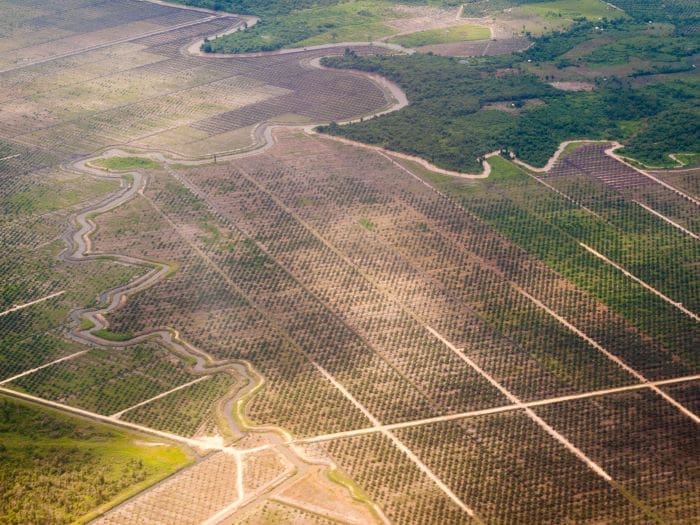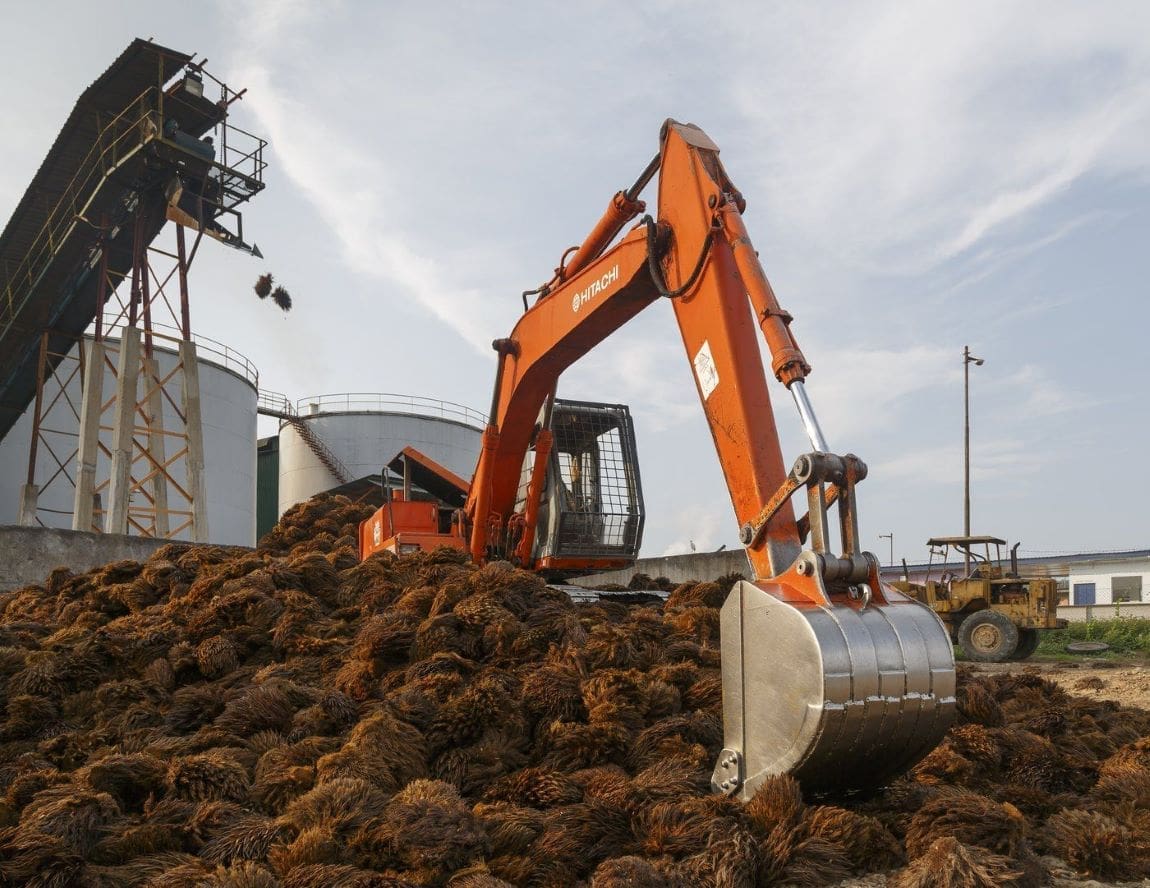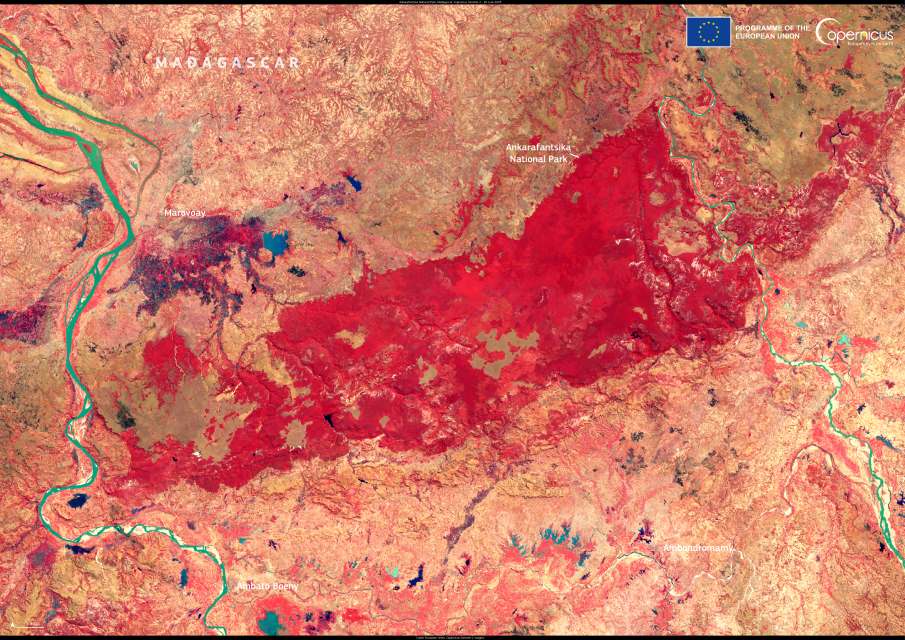By Eng-Seng Chan and Wail Gourich, Monash University Malaysia | 360info
The Malaysian palm oil industry is making notable progress in addressing climate change and sustainability issues.
Malaysia is the world’s second-largest producer of palm oil after Indonesia, with an annual output of about 19 million tonnes.
However, this thriving industry produces substantial amounts of waste.
Each tonne of crude palm oil produced generates approximately 4 tonnes of dry palm biomass and 3.5 tonnes of palm oil mill effluent.
At palm oil mills, the oil extraction process generates palm biomass, including empty fruit bunches, mesocarp fibres and palm kernel shells, as well as palm oil mill effluent.
Another major source of palm biomass is the plantation, where oil palm trunks and fronds can be found in abundance.
Energy potential
Palm biomass and waste products have an incredible potential to be converted into renewable palm bioenergy. This energy could be used to help Malaysia reduce its reliance on fossil fuels.
Palm biomass from palm oil mills alone has an estimated energy potential of about 5000 megawatts (MW) – enough energy to replace almost 40 percent of Malaysia’s yearly dependence on coal (based on 2021 data).
Biogas generated from palm oil mill effluent has an estimated energy potential of 540 MW, which is equivalent to 1.4 percent of Malaysia’s installed capacity mix (based on 2021 data).
Indeed, the prospect of palm bioenergy is promising as a means to help Malaysia transition to a low-carbon and circular economy. Palm bioenergy could also support Malaysia’s goals of achieving 70 percent renewable energy and net-zero emissions by 2050.
Despite intensifying efforts to utilise these wastes in the energy sector, most of them remain relatively untapped due to several technical challenges.
Technical challenges
Compared to woody biomass, palm biomass has relatively higher impurity contents such as ash and moisture that can affect the combustion process and efficiency. Innovations in pre-treatment technologies are needed to improve the suitability of palm biomass as boiler fuels.
Advanced technologies such as pyrolysis and gasification offer alternative avenues to maximise energy recovery from palm biomass and enhance its fuel properties. However, these technologies are still ongoing areas of research.
Financial assistance from the government such as the Green Technology Financing Scheme could assist banks in supporting companies to venture into green technology while tax benefits such as the Green Investment Tax Allowance and the Green Income Tax Exemption could potentially attract investors and green technology service providers.
The overall logistics involving biomass collection, storage, transportation and traceability add another layer of complexity and cost to the entire process.
Malaysia’s recent National Biomass Action Plan 2023-2030 is well-positioned to facilitate the sustainable management and economic development of palm biomass.
This plan entails measures such as establishing centralised biomass hubs to streamline the collection, processing and distribution of palm biomass.
Compared to dry palm biomass, palm oil mill effluent is impossible to transport, thus biogas production needs to be carried out at the palm oil mills which are often in rural areas.
Connecting to the grid
The potential of connecting biogas plants to the national grid is largely determined by the distance to the connection point, local load demand and availability of the feed-in tariff quota.
Rural palm oil mills within the same vicinity can consider connecting their biogas plants to form a mini-grid for rural electrification.
The National Energy Transition Roadmap outlines a gradual shift from fossil fuels to cleaner alternatives, including palm biomass. The roadmap has highlighted the co-firing of biomass in coal plants as a key initiative to decarbonise Malaysia’s electricity supply.
Malaysia can also continue incentivising biomass and biogas projects by leveraging existing mechanisms such as the feed-in tariff.
Ensuring sustainable practices

The palm oil industry has been labelled an environmental villain, primarily due to its association with deforestation.
Recent efforts have focused on making the palm oil industry more sustainable, driven by environmental groups, consumers and regulatory bodies.
Palm oil is notably prepared to comply with the upcoming European Union Deforestation Regulation, which takes effect at the end of this year. This regulation aims to prevent deforestation-linked products from entering the European market.
Palm oil-producing companies are required to provide due diligence statements confirming that their products are deforestation-free. Additionally, they must specify the exact geolocation for land plots of over four hectares in size.
A recent analysis shows that the Malaysian Sustainable Palm Oil certification is well-placed to help Malaysian companies comply with EU requirements.
By adhering to Malaysia’s certification standards, palm oil producers commit to ethical practices including zero deforestation and responsible land use, while safeguarding social welfare through fair labour practices.
Currently, 87 percent of the country’s 5.65 million hectares of oil palm-planted areas, and 407 of 446 palm oil mills are certified.
Malaysia has also recently formulated the Malaysian Sustainable Palm Oil Chain of Custody of Oil Palm Biomass in hopes of enhancing the traceability of palm biomass products while ensuring their adherence to rigorous sustainability criteria.
Palm oil is incredibly efficient in terms of land use. It produces four to 10 times more oil per hectare than any other vegetable oil crop, meaning it requires less land to meet global demand.
Genetic advancements are underway to enhance oil palm trees’ stress tolerance and double their oil yield. These developments are crucial as they can prevent further deforestation and agricultural expansion, which are major contributors to greenhouse gas emissions.
Malaysia has also committed to capping the total planted area to 6.5 million hectares to prevent further deforestation and preserve its rainforests. Any further land expansion will be restricted to brownfields or degraded lands only.
Indeed, palm oil’s readiness to comply with the EU regulations is a testament to the industry’s years of efforts to reduce its environmental footprint and align with global sustainability goals.
Through a combination of innovation, regulatory compliance and collaboration, the palm oil industry is making notable progress in addressing climate change and sustainability issues.
By adopting new technologies and sustainable practices, the industry is not only fulfilling its critical role in feeding and fuelling the world but also proving that it can be a valuable ally in global decarbonisation efforts.
Palm oil’s transformation from a controversial commodity to a more sustainable product demonstrates the industry’s commitment to environmental protection and social responsibility.
As it continues to evolve, the palm oil industry deserves a chance to demonstrate its commitment to protecting our planet and proving that it can be part of the solution rather than the problem.
***
Prof Ir Dr Eng-Seng Chan is a professor of chemical engineering at Monash University Malaysia. He is also the head of the Monash-Industry Plant Oils Research Laboratory, leading a team of researchers consisting of junior academics, postdoctoral fellows, technical officers and PhD students. His research interests focus on the development of novel and sustainable oil and fats processing technologies for food, fuel and oleochemical applications.
Wail Gourich is a final-year PhD student at Monash University Malaysia under the supervision of Prof Ir Dr Eng-Seng Chan. His research interest lies in the sustainable processing of oil and fats. He aspires to become a lecturer in the near future.
Originally published under Creative Commons by 360info™.
Featured image: Malaysia’s palm oil industry generates a massive 70 to 80 million tonnes of palm biomass, offering significant potential for renewable energy Credit: CEphoto, Uwe Aranas | CC BY-SA 3.0




